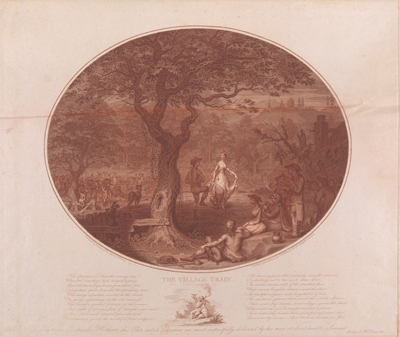The Village Train
The Village Train (1784) was created during an approximately two year sabbatical from caricature as Gillray hoped to make his mark as a serious artist and engraver. It is a large and accomplished stipple engraving, very much in the manner of Francesco Bartolozzi who was part of the faculty of the Royal Academy schools while Gillray was a student there. The print illustrates lines 15-34 from Oliver Goldsmith's popular pastoral poem The Deserted Village (1770) portraying an idealized scene from the poet's childhood as old and young members of the village (i.e. the village train) celebrate a rural holiday beneath a spreading (and very rococo-like) tree.

© Beinecke Rare Book and Manuscript Library, Yale University
The young contending as the old surveyed;
And many a gambol frolicked o'er the ground,
And sleights of art and feats of strength went round.
And still as each repeated pleasure tired,
Succeeding sports the mirthful band inspired;
The dancing pair that simply sought renown
By holding out to tire each other down,
The swain mistrustless of his smutted face,
While secret laughter tittered round the place,
The bashful virgin's side-long looks of love,
The matron's glance that would those looks reprove.
These were thy charms, sweet village; sports like these,
With sweet succession, taught even toil to please.
Decorative prints of landscape and rural scenes were popular among the aspiring middle class as were illustrations from well known literary productions like Fielding's Tom Jones and Richardson's Pamela. Gillray may have thought that in choosing to illustrate The Deserted Village he was casting the widest possible net to attract prospective customers.
Written squarely within the pastoral tradition, Goldsmith's The Deserted Village was a lament for a simple, innocent, and rural past that seemed to be quickly disappearing in 1770. Dedicated to Goldsmith's friend, Sir Joshua Reynolds, the poem was enormously successful going through six editions in little more than six months. The first edition contained an illustration on the title page by Isaac Taylor. Then in 1772, Reynolds himself created a painting based on lines from the poem subsequently turned into a print by Thomas Watson. A later edition of The Deserted Village contained multiple woodcut illustrations by Thomas Bewick.
The Village Train was not Gillray's first attempt at illustrating Goldsmith's poem. In 1783, he had produced two companion prints, Innocence and Remorse also based on The Deserted Village (lines 327ff). But both of those prints were designed (like the Reynolds/Watson effort), as portaits of a single figure.
The Village Train was a larger and much more ambitious undertaking, and, like an English version of some of Watteau's equally nostalgic prints, it shows a variety of men and women in idealized leisure activities. On the far left, we see a game of blindman's buff in progress; next to it and further behind some villagers appear to be round dancing; and beside that two men are wrestling. Further forward but still to the left of the tree, country girls seem to be trying to persuade their reluctant swains to join the central couple. In front of that couple dancing to the pipe and tabor, we get the "bashful virgin" with her hands across her lap looking towards her would-be lover. But the matron (her mother?) about to take a drink from a jug, keeps a watchful eye on him.
Though the disposition of figures in an idealized landscape is reminiscent of French models, the faces of the women with their long noses remind one of the doll-like figures of Francis Hayman and Arthur Devis. Gillray would perhaps have seen Hayman's Country Dances round a Maypole at the supper boxes at Vauxhall Gardens.
The print and its companion The Deserted Village are both dedicated by the print seller Robert Wilkinson to Henrietta Gertrude Hotham (1753-1816), the only child of the Baronet Sir Charles Hotham and his wife Lady Dorothy Hobart. In dedicating the prints to Miss Hotham, who later inherited an estate from her great aunt, Lady Suffolk, Wilkinson may have been hoping to gain a potential patron. If so, it does not appear to have worked.
Sources and Reading
- Commentary from the British Museum on The Village Train
- Draper Hill, Mr. Gillray The Caricaturist, 1965, pp. 26-29
- "The Deserted Village," Wikipedia
Comments & Corrections
NOTE: Comments and/or corrections are always appreciated. To make that easier, I have included a form below that you can use. I promise never to share any of the info provided without your express permission.